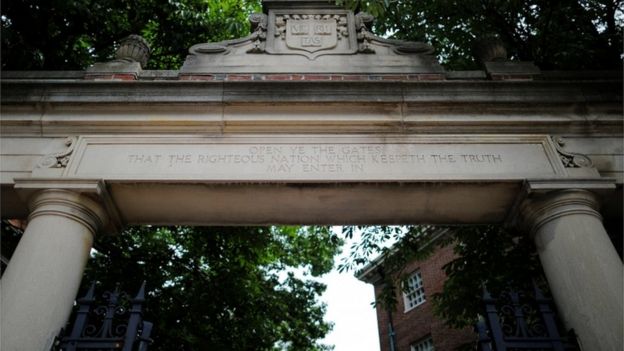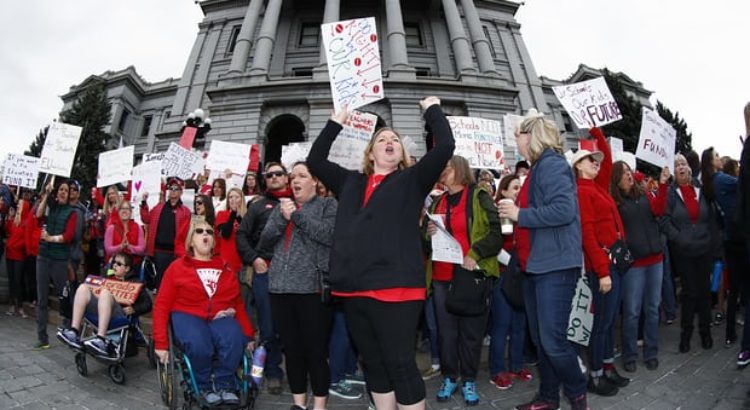North America/United States/03.07.18/Source: www.theguardian.com.
In Pennsylvania, organizers go door-to-door to make a personal case for educators as a court decision threatens union funding
Gunshots ring out from the nearby hunting range across the railroad tracks in Westmoreland City, Pennsylvania, but Jason Davis is not easily deterred.
“You never know what’s going to happen when you knock on someone’s door,” says Davis as we get out of his car to start walking the hills of this blue-collar, Trump-supporting community in the foothills of the mountains of south-western Pennsylvania.
Davis is going door-to-door to rally support for a teacher’s union after a historic supreme court decision – Janus vs AFSCME – that threatens its funding and that of all other US public sector unions.
Following last Wednesday’s ruling, non-union members will no longer have to pay “fair share” fees to be represented by unions in collective bargaining negotiations. The move could cost unions millions and lead some union members to make the decision to stop paying their dues.
For Davis, this is vital work. Over the past 15 years, the Republican-leaning school district where Davis teaches has seen the number of teachers reduced through attrition and layoffs from 320 to 270 today. He sees unions as the best way to fight back against those cuts.
While anti-union organizations have launched a broad effort to get public sector union members to stop paying dues, unions like Davis’s are going into high gear to not only retain their members, but to build on public support for teachers felt in the wake of this year’s teachers’ strikes.
As we trudge up a large hill, Davis and I meet Tim McKinney, a 24-year-old factory worker at the local General Carbide plant, who is living with his parents while working part-time. Davis starts off by introducing himself as a local teacher in the Penn Trafford school district; his kids attend McKinney’s alma mater, Norwin high school. Davis asks McKinney how he feels about education funding and they immediately start talking about the underfunding of the local high school band.
McKinney had played in the band, which is nationally ranked. But after he graduated in 2012, the then governor, Republican Tom Corbett, cut more than $1bn from the state’s education funds, and the school started instituting fees for kids who wanted to play. Now, Norwin high school parents like Davis pay $620 a year for each of their kids to play in the band.
“The band was so important to me. It taught me discipline,” says McKinney as we stand on the front porch of his parent’s house.
Davis and McKinney begin to discuss how statewide funding cuts have devastated education and how the current Democratic governor, Tom Wolf, is fighting the narrowly Republican-controlled Pennsylvania state legislature to increase funding. Davis quickly wins over McKinney as a convert to the teachers’ union cause.
“Funding education is important. We gotta support our teachers,” says McKinney as we leave his doorstep.
Davis, who canvasses the area regularly, says that conversations force people who never think about education funding to consider why unionized teachers like himself are seeking more funding.
“I just reminded him of the greatest moments of his life,” says Davis. “Now, he is going to have a conversation with his parents about what we talked about and they are probably going to talk to two or three people, which means that I helped facilitate not one conversation, but multiple conversations about education.”
A few doors down, we encounter a woman wearing a shirt depicting Joe Paterno, the controversial hero and legendary Penn State football coach. She appears a little nervous to talk to Davis. She starts to complain about how local property taxes are too high and at the same time, the school seems to be letting staff go and the quality of teaching is going down.
Davis explains to her that local property taxes have gone up as state funding of education has gone down. Davis talks for a few brief minutes, but as the reception seems less warm than at the previous home, he doesn’t stick around.
Even though the conversation isn’t quite what Davis expected, he still sees it as a victory in the fight to humanize teachers’ unions.
“For too long, we have been vilified and the only way to stop that is to put a human face on it,” says Davis. “If we want to exist, we have to sell ourselves as unions about why are we valuable. This is intensive, but it does make a difference and it will help.”
Davis and his colleagues have their work cut out for them. The Janus case was backed by some of the richest rightwing activists in the US, including the Koch brothers. As the Guardian revealed earlier this year, those groups have been planning an all-out assault on public sector unions following the Janus decision. They too will be going door-to-door and buying ads to encourage union members to rip up their membership cards and drop out now that they no longer have to pay “fair share” fees.
“In the wake of Janus, that one-on-one direct form of communication is extremely important,” says Annie Briscoe, a union organizer with the Pennsylvania State Education Association. “The ability to connect with one another is something that unions have unfortunately struggled with in recent decades. So, from an organizing standpoint, it’s very much back to basics with the canvassing effort to talk to members of the community about the nuts and bolts of public schools and why education funding works.”
Source of the notice: https://www.theguardian.com/us-news/2018/jul/01/teachers-unions-supreme-court-janus-ruling
















 Users Today : 21
Users Today : 21 Total Users : 35460152
Total Users : 35460152 Views Today : 35
Views Today : 35 Total views : 3418818
Total views : 3418818